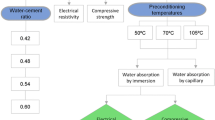Conclusions
-
1.
It is shown that in concrete without frostproofing additives hardening at −1° the ice content decreases with hydration of cement. Consequently, the process of hydration of cement does not stop but occurs, although very slowly, due to the water formed upon melting of ice.
-
2.
A hypothesis of the possible mechanism of melting of ice in concrete during isothermal hardening in the negative temperature region is proposed.
-
3.
It is confirmed that in concrete with frostproofing additives, during its hardening at a constant negative temperature, ice is released during the first days of hardening from the pore liquid due to a decrease in the concentration of additive in it, and then melting of ice is observed. It is suggested that the ice melts due to the increasing immobilization of water.
-
4.
It was established that the processes of formation and melting of ice in “cold” concrete during its hardening determine the character and extent of heat generation.
-
5.
The extent of heat generation of concrete at negative hardening temperatures does not correlate with its strength.
Similar content being viewed by others
Literature cited
Yu. G. Barabanshchikov, S. D. Okorokov, and A. A. Pariiskii, “Effect of complex frostproofing additives on heat generationsof concrete,” in: Proceedings of Hydraulic Engineering Conferences [in Russian], Energiya, Moscow, No. 118 (1978).
I. B. Zasedatelev, “Universal method of experimental determination of the evolution of heat of mortars and concretes with a programmed temperature regime,” in: Methods of Experimental Determination and Calculation of Heat Generation in Concrete [in Russian], VNIPI Teploproekt, Moscow (1971).
S. D. Okorokov and A. A. Pariiskii, “Heat generation of concrete under winter concreting conditions,” in: Second International Symposium on Winter Concreting [in Russian], Vol. 1, Stroiizdat, Moscow (1975).
A. A. Pariiskii, “Method of experimental determination of héat generation of cement under conditions of isothermal hardening of mortars and concretes,” in: Methods of Experimental Determination and Calculation of Heat Generation in Concrete [in Russian], VNIPI Teploproekt, Moscow (1971).
Guide to Performing Concreting Works [in Russian] Gosstroiizdat, Moscow (1975).
T. I. Rozenberg, V. B. Tokar', and A. A. Mamedov, “Investigation of processes of hardening of concrete with complex additives at temperatures below 0°C,” in: Second International Symposium on Winter Concreting [in Russian], Vol. 1, Stroiizdat, Moscow (1975).
Additional information
Translated from Gidrotekhnicheskoe Stroitel'stvo, No. 4, pp. 18–23, April, 1981.
Rights and permissions
About this article
Cite this article
Mironov, S.A., Pariiskii, A.A. & Barabanshchikov, Y.G. Change in the phase composition of water and kinetics of heat generation of concrete hardening at a negative temperature. Hydrotechnical Construction 15, 223–231 (1981). https://doi.org/10.1007/BF01429063
Issue Date:
DOI: https://doi.org/10.1007/BF01429063




